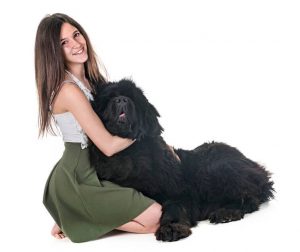Does your dog jump up on you and your guests for attention? You’re definitely not alone. There are many pet parents dealing with the very same issue.
It’s important to teach your dog that this unwanted behavior is unacceptable. Otherwise, you’ll likely end up having to put your pup in another room while friends and family visit – that’s no fun for anyone.
Here are some reasons why dogs jump up on people, as well as some training tips to stop this behavior.
Why Does Your Dog Want To Jump On People So Much?
Whether your dog is a puppy or a few years old, jumping on people is an instinctual behavior. A dog is a social animal, used to living in a group, or pack. While dogs have adapted very well to the human world, they communicate in different ways.
One of those ways is greeting others. Dogs interact with each other face to face. They like to read each other’s eyes. They want to do that with humans as well – but they can’t because humans are too tall. In order to get as close to our face as they can, they jump.1
How To Stop A Dog From Jumping On You And Others So Much
When a dog jumps on you or your friend, it can be quite annoying. But it can also be dangerous. A large dog can knock a person down, potentially causing a serious injury. So, how do you stop this troublesome form of dog behavior?
Training is key, no matter your dog’s age. One way to teach your dog not to jump is simply to ignore it. If they don’t get any attention when they jump, they may stop. You can also teach your dog to sit. Wait until your dog sits down to give them any attention. When you tell them to sit, won’t be able to do that and jump at the same time.2
As long as you’re consistent, there’s a good chance you can stop this behavior over time. But you must continue to reinforce the fact that the dog shouldn’t jump up on people. Don’t occasionally allow your pup to jump on you (or someone else) – this sends the dog mixed messages and will take them much longer to learn what it is you want them to do.3
Get Someone To Help With A Meet And Greet
When your dog is begging for attention and jumping on you, firmly tell them to “sit.” You’ll want to do the same thing when your pet wants something to eat, or if they see you going to get the leash for a walk and get super excited. Once you feel like your dog is learning self-control, have a friend come over. When your friend arrives, tell the dog to sit.
If your dog stays in the sit position, give them a treat or some other type of reward. This is known as positive reinforcement, which you’ll learn more about in a bit. Have the dog on a leash just in case it doesn’t work. If it doesn’t, tell your pet to sit again and repeat the process.4
Positive Reinforcement: Train Your Puppy With Reward Instead Of Punishment

While treats can definitely help motivate a puppy or an adult dog, affection may also work. A lot of dogs also respond well to walks and playtime. You can also start with treats and change to praise once they start to get the hang of things. If you choose not to provide a treat every time your dogs responds to a command, always give plenty of love and praise.5
You may have some professional dog trainers in your area who can help with positive reinforcement training. Talk to your vet to see if they have any recommendations.
What Is Clicker Training?

To condition your dog to the clicker, simply click the clicker and provide a treat right after. This way they will associate the clicker with getting a treat. You can then move into using the clicker to train your dog.
Say you’re training your dog to sit instead of jump up on people. When you click as soon as the dog sits, the click tells the dog they did the right thing. Then you immediately provide a treat, a toy, or praise as a reward. If you don’t want to use a clicking device, you can snap your fingers, whistle, or simply say “good boy/girl!.”6
A trainer can give you more information on clicker training or help show you how to implement it with your pet.
Reached A Dead End With Training? When To See A Veterinarian Or Professional Trainer

There are other signs your dog might need training from an expert. Here are a few.
- Guarding – This is where a dog is so possessive of a toy or some other prized possession that they growl when you try to take it. That should never happen. Eventually, the dog might try to guard your couch or your favorite chair.
- Leash pulling – When you walk your dog, you should be in complete control – not the other way around. Leash pulling is irritating but it could also be dangerous. If you have a big dog who pulls on the leash, you could fall.
- Nipping – When a puppy nips, that usually doesn’t result in any sort of serious damage. As a dog gets older, however nipping can become dangerous. Talk to a trainer if your dog continues to exhibit this type of behavior.7
Take Control Of Your Dog Constantly Jumping On People
A dog jumping on someone is annoying when it happens repeatedly. It may cause scratches on the legs or other unwanted marks. It can also be dangerous, especially if the dog is big enough to potentially knock you down. But if you take the right steps, you should be able to eliminate this problem behavior for good. Just remember to have patience and show a lot of love when your pet behaves properly.
Learn more dog training tips at Ultimate Pet Nutrition.
Get our best articles straight to your inbox.
Subscribe to The DARling below:
About the author




